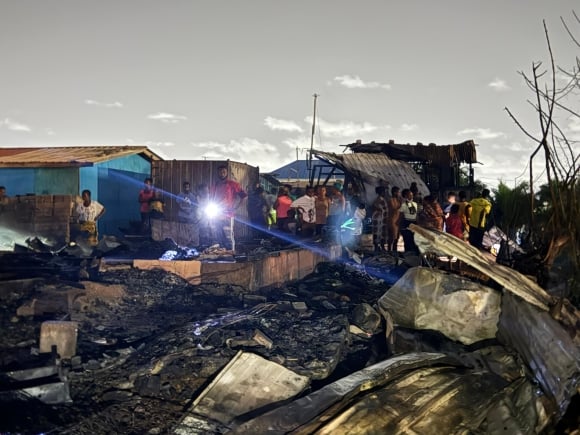The devastating fire that ravaged a slum near the Asoprochona railway station in Sakumono on Monday night serves as a stark reminder of the precarious living conditions and inherent vulnerabilities faced by residents of informal settlements. Hundreds of individuals, predominantly women and children, were left homeless as the inferno rapidly consumed their makeshift homes, reducing a vibrant community to a desolate expanse of charred debris. The speed and intensity of the blaze, fueled by the flammable construction materials and the densely packed nature of the dwellings, left residents with little time to salvage their belongings, forcing them to flee for their lives in a scene of utter chaos and desperation. This tragedy underscores the urgent need for proactive measures to mitigate the risks associated with informal settlements, including improved safety standards, access to basic amenities, and sustainable housing solutions.
The fire, which reportedly ignited around 7 p.m., spread with alarming swiftness through the tightly clustered wooden structures that characterized the settlement. Eyewitnesses recounted harrowing scenes of panic and confusion as residents scrambled to escape the rapidly advancing flames. The close proximity of the dwellings, coupled with the readily combustible nature of the building materials, created a perfect storm for the fire to propagate, leaving residents trapped in a desperate race against time. Many were forced to abandon their possessions, prioritizing the safety of their families, particularly the children, amidst the chaos and terror. The incident vividly illustrates the inherent dangers posed by the lack of adequate fire safety measures in informal settlements, highlighting the urgent need for preventative strategies and improved emergency response protocols.
The aftermath of the fire revealed a landscape of utter devastation. The once-thriving community was reduced to a smoldering wasteland, strewn with twisted metal sheets, burnt timber, and ash-covered debris. The affected area, estimated to cover an expanse of 100 meters by 40 meters, formerly housed dozens of families, who now find themselves displaced and without shelter. As night descended, the displaced residents sought refuge outside the fenced perimeter of the nearby Mount Zion Methodist Church, grappling with the shock and trauma of their loss. Their faces etched with despair, they sifted through the remnants of their homes, desperately searching for anything salvageable, a poignant testament to the human cost of such disasters.
The swift response of the Ghana National Fire Service, though commendable, highlights the challenges faced in tackling fires in densely populated informal settlements. Four fire tenders were deployed from various stations across Tema, Nungua, and Spintex, battling the inferno for nearly two hours before finally bringing it under control. The difficulty in accessing the burning structures, coupled with the rapid spread of the flames, underscores the need for specialized fire-fighting equipment and training tailored to the unique challenges posed by informal settlements. The incident reinforces the importance of community-based fire prevention strategies and early warning systems to minimize the devastating impact of such fires.
While the official cause of the fire remains under investigation, preliminary speculation points to either an electrical fault or an unattended cooking fire as the likely source. Fire officials have confirmed that a thorough investigation will be conducted to determine the precise origin of the blaze. However, regardless of the specific cause, this incident serves as a stark reminder of the systemic vulnerabilities that plague informal settlements, where inadequate infrastructure, overcrowding, and lack of access to basic services create a heightened risk of fire hazards. This tragedy underscores the urgent need for comprehensive strategies to address the root causes of such disasters and to improve the living conditions of residents in these vulnerable communities.
The Sakumono slum fire should serve as a wake-up call for authorities and stakeholders to prioritize the safety and well-being of residents in informal settlements. The incident highlights the need for a multi-pronged approach that encompasses preventative measures, improved infrastructure, and access to safe and affordable housing. This includes implementing stringent fire safety regulations, promoting community-based fire prevention programs, and providing access to fire-resistant building materials. Furthermore, addressing the underlying socio-economic factors that contribute to the growth of informal settlements, such as poverty, lack of access to land, and inadequate housing policies, is crucial for long-term solutions. The Sakumono tragedy underscores the urgent need for a collective effort to create safer and more resilient communities for all, ensuring that such devastating events are not repeated.














